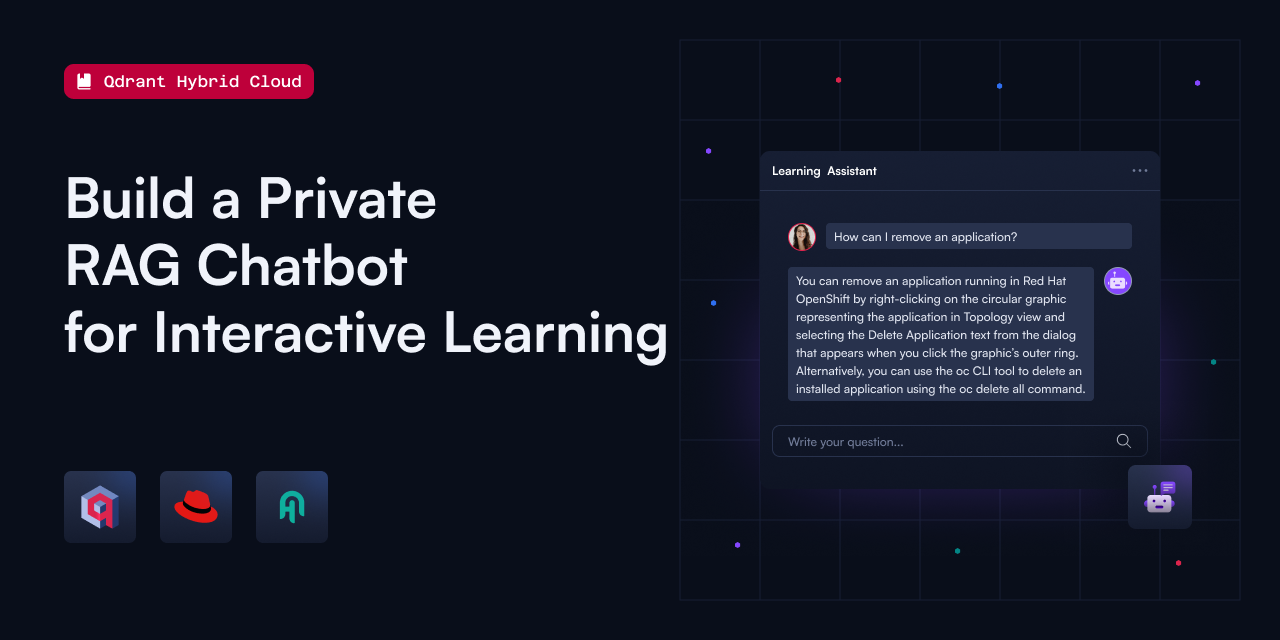Red Hat OpenShift and Qdrant Hybrid Cloud Offer Seamless and Scalable AI
Qdrant
·April 11, 2024

We’re excited about our collaboration with Red Hat to bring the Qdrant vector database to Red Hat OpenShift customers! With the release of Qdrant Hybrid Cloud, developers can now deploy and run the Qdrant vector database directly in their Red Hat OpenShift environment. This collaboration enables developers to scale more seamlessly, operate more consistently across hybrid cloud environments, and maintain complete control over their vector data. This is a big step forward in simplifying AI infrastructure and empowering data-driven projects, like retrieval augmented generation (RAG) use cases, advanced search scenarios, or recommendations systems.
In the rapidly evolving field of Artificial Intelligence and Machine Learning, the demand for being able to manage the modern AI stack within the existing infrastructure becomes increasingly relevant for businesses. As enterprises are launching new AI applications and use cases into production, they require the ability to maintain complete control over their data, since these new apps often work with sensitive internal and customer-centric data that needs to remain within the owned premises. This is why enterprises are increasingly looking for maximum deployment flexibility for their AI workloads.
“Red Hat is committed to driving transparency, flexibility and choice for organizations to more easily unlock the power of AI. By working with partners like Qdrant to enable streamlined integration experiences on Red Hat OpenShift for AI use cases, organizations can more effectively harness critical data and deliver real business outcomes,” said Steven Huels, Vice President and General Manager, AI Business Unit, Red Hat.
The Synergy of Qdrant Hybrid Cloud and Red Hat OpenShift
Qdrant Hybrid Cloud is the first vector database that can be deployed anywhere, with complete database isolation, while still providing a fully managed cluster management. Running Qdrant Hybrid Cloud on Red Hat OpenShift allows enterprises to deploy and run a fully managed vector database in their own environment, ultimately allowing businesses to run managed vector search on their existing cloud and infrastructure environments, with full data sovereignty.
Red Hat OpenShift, the industry’s leading hybrid cloud application platform powered by Kubernetes, helps streamline the deployment of Qdrant Hybrid Cloud within an enterprise’s secure premises. Red Hat OpenShift provides features like auto-scaling, load balancing, and advanced security controls that can help you manage and maintain your vector database deployments more effectively. In addition, Red Hat OpenShift supports deployment across multiple environments, including on-premises, public, private and hybrid cloud landscapes. This flexibility, coupled with Qdrant Hybrid Cloud, allows organizations to choose the deployment model that best suits their needs.
Why Run Qdrant Hybrid Cloud on Red Hat OpenShift?
Scalability: Red Hat OpenShift’s container orchestration effortlessly scales Qdrant Hybrid Cloud components, accommodating fluctuating workload demands with ease.
Portability: The consistency across hybrid cloud environments provided by Red Hat OpenShift allows for smoother operation of Qdrant Hybrid Cloud across various infrastructures.
Automation: Deployment, scaling, and management tasks are automated, reducing operational overhead and simplifying the management of Qdrant Hybrid Cloud.
Security: Red Hat OpenShift provides built-in security features, including container isolation, network policies, and role-based access control (RBAC), enhancing the security posture of Qdrant Hybrid Cloud deployments.
Flexibility: Red Hat OpenShift supports a wide range of programming languages, frameworks, and tools, providing flexibility in developing and deploying Qdrant Hybrid Cloud applications.
Integration: Red Hat OpenShift can be integrated with various Red Hat and third-party tools, facilitating seamless integration of Qdrant Hybrid Cloud with other enterprise systems and services.
Get Started with Qdrant Hybrid Cloud on Red Hat OpenShift
We’re thrilled about our collaboration with Red Hat to help simplify AI infrastructure for developers and enterprises alike. By deploying Qdrant Hybrid Cloud on Red Hat OpenShift, developers can gain the ability to more easily scale and maintain greater operational consistency across hybrid cloud environments.
To get started, we created a comprehensive tutorial that shows how to build next-gen AI applications with Qdrant Hybrid Cloud on Red Hat OpenShift. Additionally, you can find more details on the seamless deployment process in our documentation:

Tutorial: Private Chatbot for Interactive Learning
In this tutorial, you will build a chatbot without public internet access. The goal is to keep sensitive data secure and isolated. Your RAG system will be built with Qdrant Hybrid Cloud on Red Hat OpenShift, leveraging Haystack for enhanced generative AI capabilities. This tutorial especially explores how this setup ensures that not a single data point leaves the environment.
Documentation: Deploy Qdrant in a Few Clicks
Our simple Kubernetes-native design allows you to deploy Qdrant Hybrid Cloud on your Red Hat OpenShift instance in just a few steps. Learn how in our documentation.
Read Hybrid Cloud Documentation
This collaboration marks an important milestone in the quest for simplified AI infrastructure, offering a robust, scalable, and security-optimized solution for managing vector databases in a hybrid cloud environment. The combination of Qdrant’s performance and Red Hat OpenShift’s operational excellence opens new avenues for enterprises looking to leverage the power of AI and ML.
Ready to Get Started?
Create a Qdrant Cloud account and deploy your first Qdrant Hybrid Cloud cluster in a few minutes. You can always learn more in the official release blog.
























